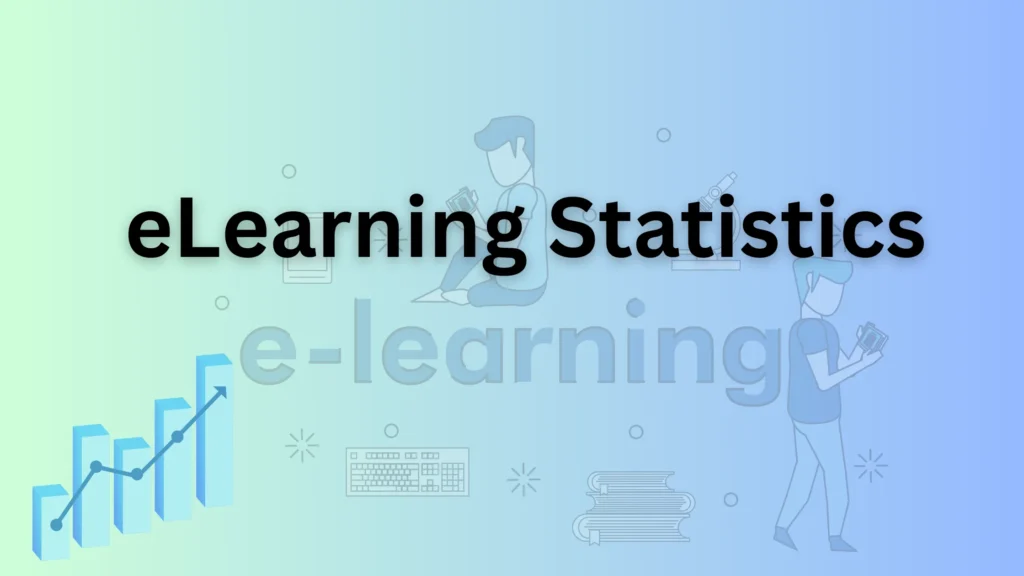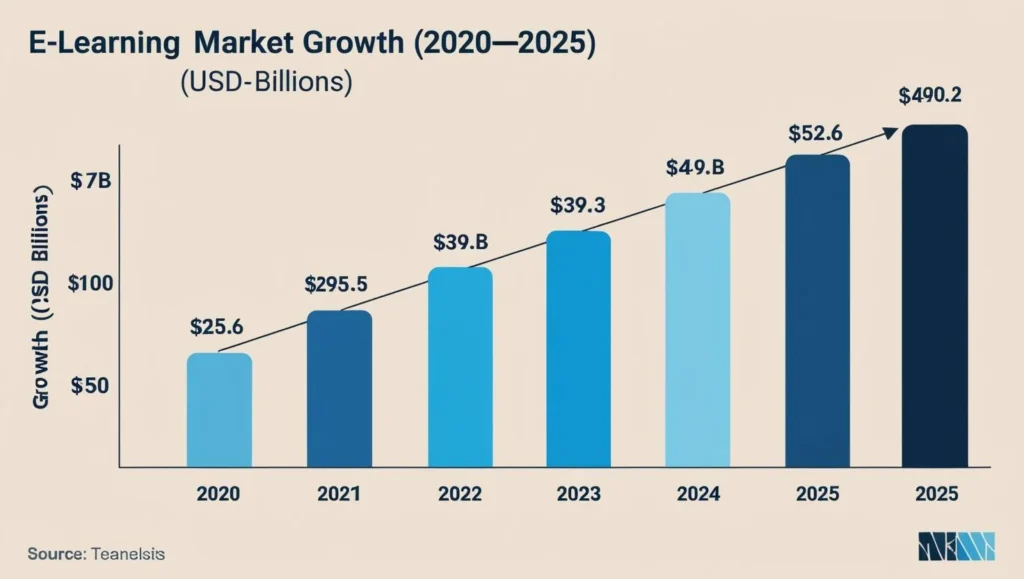eLearning has become a huge part of education and training in recent years. With more people turning to online courses, it's interesting to see how this trend is growing.
The rise of eLearning is not just about convenience; it’s also about how effective it can be for learners of all ages and backgrounds.
From higher engagement to flexible learning, statistics show just how much eLearning is shaping the future of education.
In this article, we’ll explore some key eLearning statistics that highlight its rapid growth and impact.
What is e-Learning?
E-Learning, or electronic learning, is a system where people can learn through digital platforms like search engines, social media, or other e-learning websites using electronic devices.
The “e” in e-Learning stands for electronic, making its full name “Electronic Learning.”
E-Learning is also referred to as:
- Online learning
- Digital learning
- Distance learning
- Virtual learning and more.
Basically, e-learning happens over the internet, allowing students to access educational materials anytime and from anywhere.
Some common types of e-learning include:
- Online courses
- Online degrees
- Online programs
Benefits of e-Learning
For Students
- Flexible Learning: Study anytime, anywhere, and at your own pace.
- Variety of Courses: Access a wide range of subjects and skills.
- Cost-Effective: Save money on travel, accommodation, and traditional tuition fees.
- Self-Paced: Learn at a speed that suits your understanding and schedule.
- Convenient: Study from home or any place with internet access.
For Business
- Employee Training: Easily train and upskill employees with online courses.
- Cost-Effective: Save on training costs, travel, and physical materials.
- Global Reach: Provide training to employees worldwide.
- Scalability: It offers courses to many employees without limitations.
- Consistency: Deliver uniform training to everyone, ensuring the same level of knowledge.
For Creators
- Global Audience: Share your expertise and skills with people worldwide.
- Monetize Content: Earn income by offering courses, workshops, or tutorials.
- Creative Freedom: Design your own courses, tutorials, and materials.
- Engagement: Connect with learners through interactive features like quizzes, discussions, and feedback.
- Build Your Brand: Establish yourself as an expert in your field.
30+ eLearning Statistics in 2025

Undoubtedly, there is a high rise in the e-learning industry; moreover, the adoption of online learning is increasing daily by various industry professionals.
Now, let's learn some statistics, trends, and demographics to understand how this industry is growing.
e-Learning Statistics: Editor's Choice
Here are some must-know e-Learning statistics.
- Fastest-Growing Market: The online learning industry has seen a remarkable 900% growth since 2000, making it the fastest-growing sector in education.
- Corporate e-Learning Adoption: According to LinkedIn, nearly 90% of corporate businesses offer e-learning opportunities to their employees.
- Environmental Impact: e-Learning courses generate 86% fewer greenhouse gases, as reported by Skill Scouter, due to reduced travel and fewer CO2 emissions from transportation.
- Cost Savings: IBM saved around $200 million after implementing technology-driven distance learning for computer training and management development.
- Video Content in Learning: Video content plays a crucial role in online education, contributing to significant product sales. For instance, Sony sold 500 million PlayStation VR devices in 2017 through online learning-related marketing.
(Source: LinkedIn, Sh!ft, KPMG, eLearning Industry)
General e-Learning Statistics
Let's learn some common usages of e-Learning statistics in this day and age.
- Almost every mobile user (99%) states that mobile learning increases their learning experience.
- Online learning takes 40 to 60% less learning time than conventional classrooms.
- E-learning has created a socio-economic gap, as 25-33% of students do not have access to resources.
- Since 2020, 98% of universities have shifted to online learning.
- Before that, 19.5% of undergraduate students had attended at least one online course.
- National Centre for Educational Statista reports that women are much more interested in participating in e-learning. For example, 17% of women enroll online, whereas 13% of men participate in e-learning.
- Glassdoor's research shows that the average wage for professional online learning developers is $79,526.
- The average salary for LMS developers is nearly $20,000 higher than the national average annual salary.
(Source: NCES, Market Research)

Growth Statistics of the e-Learning Industry
The online learning industry is expanding daily regarding its value, usage, revenue, and users.
Consequently, it has become a billion-dollar industry.
- The corporate e-learning sector's value is anticipated to be $50 billion by 2026.
- The US eLearning market is anticipated to grow by 12.81 billion US dollars between 2020 and 2024.
- The revenue of online learning platforms is expected to reach 56.69 billion US dollars in 2022.
- The revenue is expected to show an annual growth rate (CAGR 2022-2027) of 2.61%, resulting in a projected market volume of $64.50 billion by 2027.
- Online learning platforms are expected to have 902.3 million users by 2027.
- Finance Online reports that the mobile eLearning market is projected to reach 38 billion dollars by 2021.
- On the contrary, the self-paced e-learning market is anticipated to decrease by $33.5 billion by the end of 2021.
- The growth of the self-paced industry is declining day by day and is likely to fail. 42% of all companies that adopted e-learning produce more income.
- Statistics by Tech Jury also say e-Learning not only saves money but also helps generate more company revenue. Over 4 out of 10 companies use online learning.
- The use of distant management applications for academic goals grew by 87%.
(Source: Market Research, Tech Jury, Business Wire)
Corporate e-Learning Statistics
More than half of the companies saved thousands to millions of dollars using e-learning.
Also, the employees enhance their productivity and skills through online learning, which indirectly helps company growth.
- Approximately 82% of companies implement e-Learning to lead an organization's compliance training.
- Training Mag states in their 2018 industry report that more than 3 out of 4 businesses hosted some compliance training curriculum online.
- 28% of companies offered 100% of their compliance training online.
- The corporate learning sector is anticipated to grow by 15% yearly. Corporations account for the highest adoption rate of e-learning.
- 62% of all companies utilize digital learning to bridge the gaps in employee knowledge. Also, 62% of organizations state that they implement e-Learning for different purposes in the organization, but online learning primarily addresses employee knowledge gaps.
- An article by Skill Dynamic reports that about 41.7% of Fortune 500 companies utilize some method of e-learning to teach their employees.
- This article also mentions that eLearning plays a key role for corporations in decreasing employee disturbance and increasing their excitement and collaboration during training.
- Finances Online says that 93% of global companies are scheduled to adopt and utilize e-Learning.
- A study published by the American Heart Association shows that employees improve their productivity by 15%-25%. Hence, online learning can grow company revenue.
- Learning can improve employee engagement by up to 18%. Papers Owl reports that during online learning, employees who take part are more engaged than those who don't.
- National Centre for Education Statistics states that 58% of employees choose online learning as they can learn anything in their comfort. This is also a major benefit of e-Learning.
- Most employees say they learn five times better online than in-person teaching.
(Source: Training Mag, American Heart Association, Udemy, Business Wire, NCES, Papers Owl)
Academic eLearning Statistics
The number of e-learning learners in academics skyrocketed just because any student can learn any course online, from the English language to the programming language.
- US e-Learning Statistics report that about 63% of American high school students use digital learning tools.
- Approximately 45% of elementary school students in the USA employ at least one digital tool daily for learning.
- Nearly 64% of middle school students employ a minimum of one digital learning tool daily.
- The online learning trend is rising in the USA. Research says more than half, 52% of American students choose online learning. Additionally, 39% of undergraduates go for e-learning.
- 49% of students across the globe state they have taken an online course within the last twelve months. Statistics of online education display that the number was 46% in 2013.
- 33% of post-secondary school administrators are ready to continue eLearning- online and remote courses after their campuses are open again.
- Such statistics display that educational organizations and institutions identified the advantages of e-learning.
- 43% of students believe digital learning tools are a great medium to attend online classes and lectures and complete their assignments.
- Nearly half of the students feel that electronic learning helps them study and complete their homework and notes effectively when they are out of reach from the classroom.
- The retention rate of students in e-Learning courses is between 35% and 60%, nearly 3x higher than in face-to-face courses. In offline courses, students retain only 10% of the learning.
- 22% of graduates participate solely in online courses. However, most students choose person-to-person college courses for learning.
- 20% of graduate students currently participate in online courses to achieve their degree certification.
- Online courses are superior to face-to-face courses. For example, 41% of students stated their e-Learning courses were more effective than offline classes. This will result in increased growth in online learning options in educational institutions.
- In-person or offline classes take time to complete. On the other hand, e-learning courses can be completed about 60% faster than in-person classes as students get so much time.
- More than half, almost 67% of American college students have completed some or all of their course activities by using mobile phones.
- Distance learning statistics report that 17% of women are more likely to participate in e-Learning.
- According to the College Crisis Initiative, over 1200 schools and colleges in over 50 states suffered from covid-19 endemic.
- 44% of institutions select e-learning platforms and tools. Digital learning was the ultimate medium of learning.
- 21% of colleges adopted a hybrid model of education.
- 27% of institutions continued with in-person learning full-time.
- Of the schools that offered one or more online courses, 81.9% were elementary schools.
- 3% of intermediate schools offered at least one online course, whereas only 53.8% of secondary schools offered this option.
- In the USA, 57% of all students had digital learning tools in 2019.
- 40% of student device use went to educational platforms.
- In 2021, 75% of schools in the United States plan to operate completely online.
- 71% of teachers are concerned about increased engagement in online courses.
- 33% of teachers agree that they should redesign courses to accommodate online media.
- 31% of teachers are concerned about enhancing student cooperation.
(Source: Market Research, Papers Owl, UTEP Connect, EducationData.org, Statista, Skill Scouter, Statista, Learning House, AMR – Statista 2020)
eLearning Statistics of Financial Affairs
Here, you will learn how big brands are saving millions of dollars by moving to e-learning from traditional ways of training.
Also, you will get information on how much it takes to create or purchase an online course.
- IMB saved about 200 million dollars by shifting from traditional training to e-learning.
- Every business spends a lot of money on employee development. This accounts for a significant portion of corporate budgets. But with the help of e-learning, companies save money and time.
- Business owners save money by adopting e-Learning and teaching their employees efficiently.
- As a result, companies that utilize eLearning over traditional ways of training generate over ¼ revenue per employee.
- The average cost of creating an online course ranges from $144 to $10,800. But the price is determined by certain factors like the number of modules and the certifications you want to offer.
- The average price for an online course amounts to $177. Though it takes around $10,000 to create a course, the price of an online course is low.
- Moreover, creators get a good profit in return as you can sell courses repeatedly once it is created, and there is only one manufacturing cost.
- The corporate e-learning industry is projected to reach 50 billion dollars by 2026 with constant growth of 15%.
(Source: Sh!ft, Sell courses online)
Statistics of e-Learning Platforms
As the cost of data continues to decrease, more people are turning to online learning to acquire new skills or enhance existing ones. This shift has led to a surge in the demand for online courses, prompting creators to develop various e-learning platforms to meet this need. Below are some key statistics on popular e-learning platforms:
- Udemy:
- Active Students: Udemy now boasts over 50 million active students.
- Course Offerings: The platform hosts over 200,000 courses across various subjects, including professional topics like technology, business, design, finance, and more.
- Free Courses: Udemy continues to offer a wide selection of free courses alongside paid content.
- Market Reach: As one of the largest online learning platforms since its inception in 2009, Udemy has become a leader in the industry.
- Teachable:
- Course Categories: Teachable remains a popular choice for professionals offering courses in areas such as marketing, self-development, and food & drink.
- Popular Course: One of the most popular courses on Teachable is “Email Marketing Magic”, priced at $399. This course covers the skills, tactics, strategies, and tools necessary for email marketing.
- Revenue Generation: Creators using Teachable have generated over $1 billion in revenue from course sales.
- Average Revenue per User: The average revenue per user (ARPU) on Teachable is around $83.14.
- Thinkific:
- Thinkific is another key platform where creators have earned substantial revenue by offering online courses, contributing to the growth of the e-learning market.
Popular eLearning Platforms:
Other platforms gaining significant traction include WizIQ, Academy Of Mine, Ruzuku, Educadium, LearnWorlds, and more, all providing creators and learners with diverse course options and tools.
(Source: Udemy, Teachable, Statista, Sell Courses Online)
eLearning Statistics of Different Countries
Almost 9 out of 10 countries use online learning. Developed countries are the ones that have started using online learning.
Let's learn e-learning statistics of some specific countries and regions and how common folks utilize e-Learning in those regions.
- Almost 90% of the countries adopted e-Learning processes by using gadgets.
- China, the United Kingdom, the United States, India, and South Korea spent the most money on online learning.
- The user penetration rate of e-learning platforms is the highest in China, with an anticipated rate of 23.2%.
- In February 2020, 250 million Chinese students shifted to online studying full-time.
- Germany is the European frontrunner in the e-learning sector and has the highest market share, with an 8.5% growth rate year on year.
- The e-learning market in India is anticipated to grow by 14.33 billion by 2024.
- Tata Interactive Systems is one of India's most popular course platforms.
- In India, some favorite topics among learners are digital marketing, social media marketing, language learning, graphic designing, artificial intelligence, and many more.
- The Asia Pacific region has the highest growth in the learning industry, with a growth rate of 17.3%. On the other hand, the average growth rate of the globe is 7.6%.
- Eastern Europe, Africa, and Latin America are also growing in the e-Learning industry.
- The K -12 online education system in China is providing great value to schools and students, and during the pandemic, the whole education system was dependent on e-learning. Since 2017, their e-learning market has grown by 20%.
- The US and European markets account for 70% of the majority of users in the global market for online learning services.
- Few countries like China, Italy, and South Korea were the first to get badly affected by coronavirus. These countries invested in online studying tools and platforms and utilized online homeschooling to continue the learning process.
- For e-learning, students need gadgets like smartphones, laptops, or PCs. Fortunately, 95% of Switzerland and Norway students were lucky to get one device. In comparison, only 34% of students in Indonesia had that advantage.
- Most 15-year-old USA teenagers have gadgets. On the other hand, 25% from deprived backgrounds have no access to devices.
- The USA alone accounts for over 31% of mobile learning expenditures in the global market.
- 83% of the countries implemented online platforms to keep up the learning process.
- Government policies have made it possible to attain at least 69% of countries through broadcasting or media for educational purposes.
(Source: Statista, elearn2grow.com, Market Research, Docebo)
Latest Statistics to take a look at:
- Essential Instagram Statistics Marketers Should Know
- Google Search Statistics: Key Facts and Trends✅
- Semrush Statistics: Latest Facts About a Big SEO Tool🚀
- Affiliate Marketing Statistics You Should Know
- Latest Social Media Marketing Statistics
Conclusion
e-Learning has quickly become a key part of education and training, offering flexible, cost-effective learning options.
Platforms like Udemy, Teachable, and Thinkific are driving this growth, providing a wide range of courses for both businesses and students.
With continued growth expected, e-learning is shaping the future of education and skill development globally, making learning more accessible to everyone.







